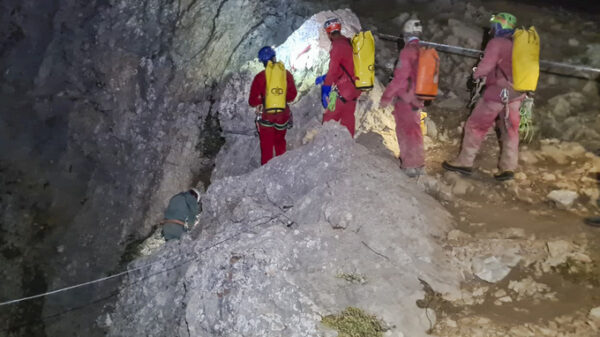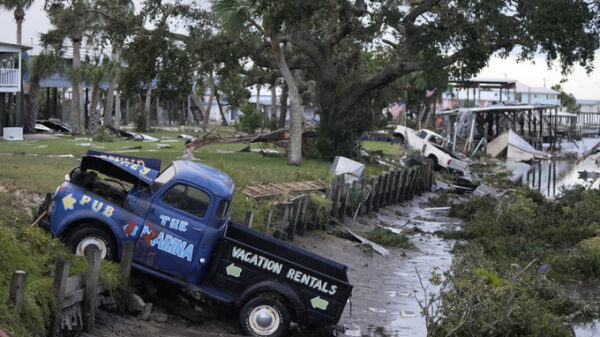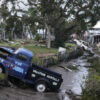A house sits in Rock Creek after floodwaters washed away a road and a bridge in Red Lodge, Mont., Wednesday, June 15, 2022. (AP Photo/David Goldman)
BILLINGS, Mont. (AP) — Damaging floodwaters that tore through Yellowstone National Park menaced communities downstream where residents cleaned up from the mess and kept an eye on rising river levels while others braced for the economic fallout while the park remains closed.
After wiping out miles of roads and untold number of bridges in the park and swamping hundreds of homes in surrounding communities, the roiling waters threatened to cut off fresh drinking water supplies to Montana’s largest city.
Officials asked Billings residents Wednesday to conserve water because it was down to a 24- to 36-hour supply after a combination of heavy rain and rapidly melting mountain snow raised the Yellowstone River to historic levels that forced them to shut down its water treatment plant.
“None of us planned a 500-year flood event on the Yellowstone when we designed these facilities,” said Debi Meling, the city’s public works director.
While expressing optimism the river would drop quickly enough for the plant to resume operations before tanks were drained, the city of 110,000 stopped watering parks and boulevards, and its fire department filled its trucks with river water.
Cory Mottice, with the National Weather Service in Billings, said the river was expected to crest Wednesday evening and drop below minor flood stage, 13.5 feet (4.1 meters), by mid to late Thursday.
The unprecedented and sudden flooding earlier this week drove all but a dozen of the more than 10,000 visitors out of the nation’s oldest park.
Remarkably no one was reported hurt or killed by raging waters that pulled homes off their foundations and pushed a river off course — possibly permanently — and may require damaged roads to be rebuilt a safer distance away.
On Wednesday, residents in Red Lodge, Montana, a gateway town to the park’s northern end, used shovels, wheelbarrows and a pump to clear thick mud and debris from a flooded home along the banks of Rock Creek.
“We thought we had it, and then a bridge went out. And it diverted the creek, and the water started rolling in the back, broke out a basement window and started filling up my basement,” Pat Ruzich said. “And then I quit. It was like, the water won.”
While the Yellowstone flood is rare, it is the type of event that is becoming more common as the planet warms, experts said.
“We certainly know that climate change is causing more natural disasters, more fires, bigger fires and more floods and bigger floods,” said Robert Manning, a retired University of Vermont professor of environment and natural resources, “These things are going to happen, and they’re going to happen probably a lot more intensely.”
Park officials say the northern half of the park is likely to remain closed all summer, a devastating blow to the local economies that rely on tourism.
The rains hit just as area hotels filled up in recent weeks with summer tourists. More than 4 million visitors were tallied by the park last year. The wave of tourists doesn’t abate until fall, and June is typically one of Yellowstone’s busiest months.
The season had started well for Cara McGary who guides groups through the Lamar Valley to see wolves, bison, elk and bears. She’d seen more 20 grizzlies some days this year.
Now, with the road from Gardiner into northern Yellowstone washed out, the wildlife is still there but it’s out of reach to McGary and her guide service, In Our Nature, is suddenly in trouble.
“The summer that we prepared for is not at all similar to the summer that we’re going to have,” she said. “This is an 80% to 100% loss of business during the high season.”
Flying Pig Adventures, a Gardiner-based business that guides rafting trips on the Yellowstone River, will need to rely more on tourists staying in Montana now that roads into the park are impassible, co-owner Patrick Sipp said Wednesday.
It’s a blow not unlike how COVID-19 temporarily shut down Yellowstone two years ago, reducing the park’s June 2020 tourist visits by about one-third before they rebounded over the rest of that summer.
“We’re definitely a resilient company, we’ve got a very tough crew,” Sipp said. “But it’s devastating. You just hate seeing stuff like that in the community. We’re just hoping that we can get back out there relatively soon.”
Meantime, as the waters recede, parks officials are turning their attention to the massive effort of rebuilding many miles of ruined roads and, possibly, hundreds of washed-out bridges, many of them built for backcountry hikers. Yellowstone Superintendent Cam Sholly said assessment teams won’t be able to tally the damage until next week.
Kelly Goonan, an associate professor at Southern Utah University and an expert in national parks and recreation management, said rebuilding will be a long process.
“This is something we’re definitely going to feel the impacts of for the next several years,” Goonan said.
Whitehurst reported from Salt Lake City. Associated Press writers Amy Beth Hanson in Helena, Mead Gruver in Cheyenne, Wyoming and Brian Melley in Los Angeles contributed to this report.
Copyright 2021 Associated Press. All rights reserved.






























You must be logged in to post a comment Login